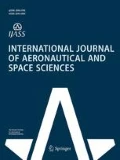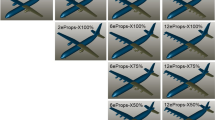Abstract
A blended-wing-body aircraft with distributed propulsion system is a new design concept proposed in recent years to achieve the N + 3 goal. Distributed engines can be embedded on different positions on the upper surface of the aircraft due to its smaller size compared with the traditional engines. Different installation positions can influence not only the aerodynamic characteristics but also the engine performance, especially during the off-design conditions such as takeoff condition. Thus, a propulsion/airframe integration analysis method was developed to calculate the performance of several configurations with different engine positions at takeoff condition. We found that there is strong coupling between the aerodynamics and propulsion efficiency, and that the span position of the propulsion system has more significant effects on the performance of the aircraft compared with its chord position.










Similar content being viewed by others
References
Liebeck RH (2004) Design of the blended wing body subsonic transport. J Aircr 41(1):10–25
Mody PC, Sato S, Hall DK, de la Rosa Blanco E, Hileman JI (2010) Conceptual design of an N + 3 hybrid wing body subsonic transport. 28th AIAA applied aerodynamics conference, Chicago, Illinois
Leifsson LT, Mason WH, Schetz JA, Grossman B, Haftka RT (2013) MDO of a blended-wing-body transport aircraft distributed propulsion. Aerosp Sci Technol 25(1):16–28
Schetz JA et al (2010) Propulsion and aerodynamic performance evaluation of jet-wing distributed propulsion. Aerosp Sci Technol 14(1):1–10
Jo YH, Chang K, Sheen DJ et al (2015) Numerical simulation of aerodynamic characteristics of a BWB UCAV configuration with transition models. Int J Aeronaut Space Sci 16(1):8–18
Daniel M, Tompkins, Sexton MR (2016) Computational evaluation of inlet distortion on an ejector powered hybrid wing body at takeoff and landing conditions. 54th AIAA aerospace sciences meeting, San Diego, California, USA
Rodriguez DL (2009) Multidisciplinary optimization method for designing boundary-layer-ingesting inlets. J Aircr 46:883–894
Kim HD, Brown GV, Waters M, Hall D (2009) Next generation more-electric aircraft: a potential application for HTS superconductors. IEEE Trans Appl Supercond 19(3):1055–1068
Kim HD, Berton JJ, Jones SM (2006) Low noise cruise efficient short take-off and landing transport vehicle study. 6th AIAA Aviation Technology, Integration and Operations Conference (ATIO), Wichita, Kansas
Kim H, Liou M-F, Liou M-S (2015) Mail-slot nacelle shape design for N3–X hybrid wing-body configuration. 51st AIAA/SAE/ASEE Joint Propulsion Conference, Orlando, FL
Author information
Authors and Affiliations
Corresponding author
Rights and permissions
About this article
Cite this article
Lian, Z., Wu, J. Aerodynamics and Propulsive Efficiency of a Blended-Wing-Body Aircraft with Distributed Propulsion System During Takeoff. Int. J. Aeronaut. Space Sci. 19, 799–804 (2018). https://doi.org/10.1007/s42405-018-0066-7
Received:
Revised:
Accepted:
Published:
Issue Date:
DOI: https://doi.org/10.1007/s42405-018-0066-7




